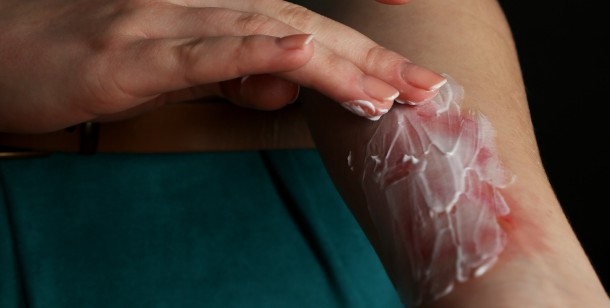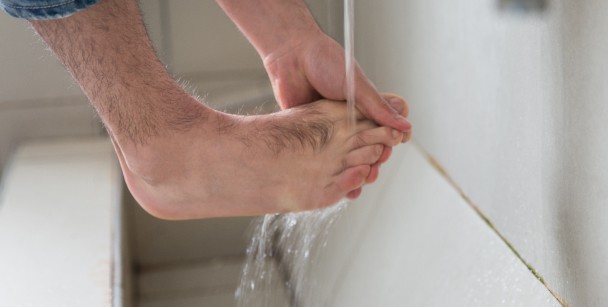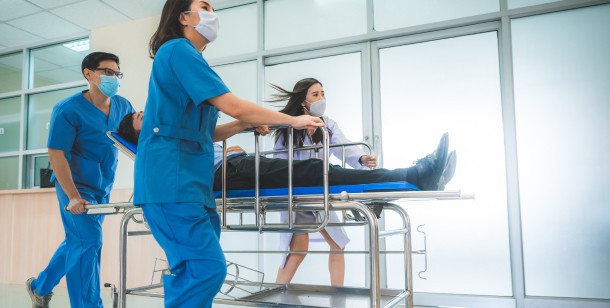Did you know that burn centers see a rise in patient traffic during the holiday season? This is because, during this time of year, there are ample opportunities for accidental burns to occur. Whether it is attempting to fry that turkey outdoors for the first time, hanging the Christmas lights, or lighting up the fireplace on a cold winter’s night, burns happen. That’s why it’s important to know how to identify and care for burns at home, and to know when to see a doctor for a burn. Keep reading to learn more!
How Do You Know How Serious a Burn Is?
There are four standard types of burns that are measured by levels of severity. Additionally, we will discuss two specific kinds of burns that come from chemicals and electricity.

First Degree Burns
A first-degree burn is considered a minor burn, and can usually be treated at home. A mild sunburn is an excellent example of a first-degree burn. Symptoms of this mild burn may include redness, tenderness, warmth, and eventual peeling.
Second Degree Burns
Second-degree burns usually penetrate two layers of skin, the epidermis, and dermis. These burns usually involve blisters, as well as redness, swelling, and pain. Depending on the size and location of said burn, medical attention may be required.
Third Degree Burns
Third-degree burns are much more serious than the previous two levels. This burn penetrates through all layers of skin and may begin to affect the muscle and bone. Skin around a third-degree burn may appear charred or white and leathery. With the question of when to see a doctor for a burn, seek medical attention for a third-degree burn immediately.
Fourth Degree Burns
Much like third-degree burns, fourth-degree burns are incredibly severe in nature and require immediate medical care. These burns affect the muscle and bone, after burning through all the layers of skin. Additionally, these burns may be without pain, as the nerve endings in the burn area have likely been damaged or destroyed.
Chemical Burns
Also called “caustic burns,” chemical burns are caused by a corrosive substance coming in contact with the eyes, skin, mouth, or internal organs. Chemical burns can be classified by the levels of burn severity described above and can be caused by substances like: ammonia, bleach, battery acid, or pool chlorinators.
Electrical Burns
As you might imagine, an electrical burn is caused by an intense electrical current passing through the body. These burns may be worse than they appear on the surface and can continue to worsen visibly over time and we recommend getting help when asking when to see a doctor for a burn for these cases. Electrical burns can be caused by electrical outlets, power lines, household appliances, and in some cases, lightning. Symptoms include: burns or other wounds visible on the skin, pain, seizures, dizziness, weakness, mobility issues, abnormal heartbeat or breathing patterns, and red or reddish-black urine.
Does My Burn Need Medical Attention?
Each burn has different care requirements, and it’s important to know what they are should you find yourself taking care of a burn injury at home.
First Degree Burn Treatment
As we’ve learned this is usually a minor burn situation that can be treated at home. Run cool water over the burned area, or apply a cool compress to alleviate discomfort. Apply a petroleum-based ointment, like aloe vera, two to three times a day and take over-the-counter pain medication for pain relief. This burn should heal in seven to 10 days; if peeling occurs, try your best not to pick at it!

Second Degree Burn Treatment
Second-degree burns are a bit more serious than first-degree burns but can be treated at home if they are not severe in nature. For second-degree burns, immerse the burn in cold water or apply a cool compress, avoiding cold or ice as this might cause further damage. If the blisters are not broken, leave them intact, as this can help prevent infection. If blisters have opened, gently clean the open wounds and place a thin layer of antibiotic ointment over them before bandaging lightly. Remove jewelry or restrictive clothing to avoid complications in the event of swelling. Keep wounds clean.
Third & Fourth Degree Burn Treatment
Third and fourth-degree Burns should immediately be treated by a medical professional. In the event of a severe burn, do the following:
- Take protective measures. You will not be able to help an injured person if you are in danger of being injured yourself.
- Eliminate the danger. Extinguish any active flames. Avoid moving injured people as much as possible.
- Call an ambulance or head to an emergency center and request help.
While you wait for help:
- If possible, raise the injured body part above the person’s heart.
- Cover the affected area with a clean, loose bandage or cloth.
Do NOT:
- Apply ice, as this could cause further tissue damage.
- Apply creams or ointments to the wounds.
- Remove clothing stuck to the burn.
- Pick, peel, or attempt to remove burned skin or blisters.
Chemical Burn Treatment
In the case of a chemical burn, it is important to proceed with caution. As you move to help the injured person, wear gloves to avoid getting the caustic chemical on yourself and do the following:
- Remove the liquid chemical substance by running the afflicted area under copious amounts of cool water.
- For dry chemicals, using something other than your hand, brush off any remaining material before adding water. Some dry chemicals are activated or made worse by water.
- Remove restrictive clothing or tight jewelry that may worsen swelling.
- Cover burns with a light sterile gauze or clean cloth. Avoid applying bandages too tightly.
- Flush area again as needed if irritation continues to occur.
- Call Poison Help at 800-222-1222 (US) to get specific details for handling specific chemical injuries.
Electrical Burn Treatment
People suffering from severe electrical burns should receive immediate medical assistance. However, this situation could be very dangerous; proceed with caution and do the following:
- Avoid contact with the injured person if he or she is still being exposed to the electrical current.
- If possible, turn off the source of the electrical current. If not, move the source away from people using a dry, nonconducting object (wood, plastic, cardboard, etc.).
- Avoid moving the injured person as much as possible if they are out of immediate danger.
- Call an ambulance or head to an emergency center and request help.
While waiting for medical assistance do the following:
- Administer CPR if the injured person shows no signs of breathing.
- Prevent the injured person from being chilled.
- Apply loose, clean cloth bandages over open wounds. Do not use cloth made of fibers that may stick to the burns.
How Bad Should a Burn Be to Go to the Hospital?
Now, we answer the real question: when to see a doctor for a burn? Keep in mind, no matter the degree of burn, it is a good idea to seek our urgent care if your burn falls into any of the following categories:
- Covers large areas of the body.
- Covers a major joint.
- Covers the hands, feet, face, or genitals.
- Is a third or fourth-degree burn.
- Is a severe chemical or electrical burn.
- Shows sign of infection after initial treatment.
While first-degree burns and some second-degree burns can often be treated at home, if any of the characteristics above qualify for your burn, it would be wise to head to the emergency department of your nearest urgent care facility or hospital to receive medical care and a proper burn assessment.

Village Emergency Center Treats Severe Burns
When you or a loved one is suffering from a severe burn, be sure to seek help from a medical professional at your nearest emergency room. Our center is open 24/7, so help is available immediately for anyone who needs it. Remember, the best way to treat burns is to prevent them from happening in the first place. Be sure to practice fire safety in your home this holiday season.
